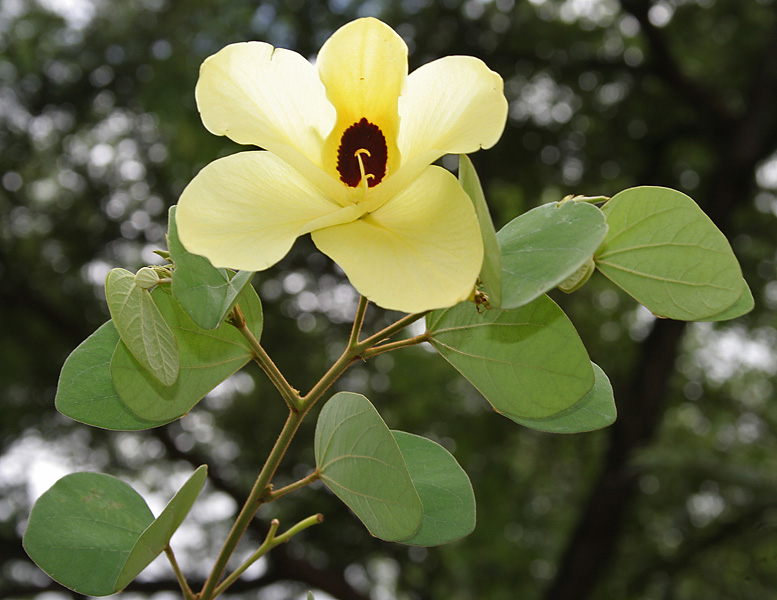Bauhinia tomentosa.

|
|
Bauhinia tomentosa Common Names: St. Thomas Tree Scientific
Classification Kingdom: Plantae Phylum: Angiosperms Class: Eudicots Order: Fabales Family: Fabaceae Genus: Bauhinia Species: Bauhinia tomentosa Synonyms: Alvesia
bauhinioides Welw., Alvesia tomentosa (L.) Britton & Rose, Bauhinia
pubescens DC., Bauhinia volkensii Taub., Bauhinia wituensis Harms, Pauletia
tomentosa (L.) A.Schmitz Morphological Description Bauhinia tomentosa,
commonly known as the St. Thomas Tree, is a medium to large shrub or small
tree, typically growing 4–8 m tall, occasionally reaching 10 m. It is
characterized by: · Stem: Branches are slender, often drooping, with young twigs
covered in fine, velvety hairs, maturing to smooth, grey-brown bark (South
African National Biodiversity Institute [SANBI], 2024). · Leaves: Alternate, bilobed, light green, leathery, 3–7 cm long and
wide, with a heart-shaped base and rounded lobes; surfaces are slightly
pubescent, especially beneath (Fern, 2024). · Flowers: Large, bell-shaped, 5–7 cm in diameter, bright yellow with a
black to deep maroon center; produced in pairs or solitary from mid to late
summer (December–March in the Southern Hemisphere) (SANBI, 2024). · Fruits: Slender, pea-like pods, 10–15 cm long, velvety, light green
when young, turning pale brown and dehiscent when mature; produced from January
to June, containing 6–10 flat seeds (Fern, 2024). · Seeds: Flat, dark brown, 8–10 mm long, embedded in the pod (SANBI,
2024). The plant’s vibrant
flowers and drooping branches enhance its ornamental appeal, making it a
popular choice for gardens and landscaping (Fern, 2024). Distribution and Habitat Bauhinia tomentosa is
native to Africa, with a range extending from Ethiopia, Kenya, and Somalia
south to South Africa, and west to the Democratic Republic of Congo and Angola.
It is also found in Asia, including India, Sri Lanka, and Malaysia, where it is
naturalized or cultivated. The species thrives in: · Climatic conditions: Tropical and subtropical climates with
annual rainfall of 400–1,200 mm and temperatures of 18–30°C; tolerates light
frost (Fern, 2024). · Altitude: Sea level to 1,500 m, occasionally up to 2,000 m in East
Africa (Kew Science, 2024). · Habitats: Woodlands, riverine thickets, coastal dune bush, forest
edges, and savanna; often found in disturbed areas or along watercourses due to
its preference for well-drained, fertile soils (SANBI, 2024). · Soil types: Sandy loam to clay soils with pH 5.0–7.5; moderately
drought-tolerant but sensitive to waterlogging (Fern, 2024). The species is widely
cultivated as an ornamental plant in tropical regions and has become
naturalized in parts of Asia and Australia due to its adaptability (Kew
Science, 2024). Ethnopharmacology Bauhinia tomentosa is
extensively used in African and Asian traditional medicine, with
pharmacological studies validating several applications: · Nephroprotection: In Nigeria and India, root and leaf
extracts are used to treat kidney disorders. Methanolic leaf extracts (250
mg/kg) significantly increase antioxidant enzymes (superoxide dismutase,
glutathione, catalase) and reduce lipid peroxidation, serum urea, and
creatinine in cisplatin-induced renal damage in rats, supporting its
nephroprotective potential (Sathasivampillai et al., 2020). · Antidiabetic effects: In Sri Lanka, flower ethanol extracts (100
mg/kg) exhibit antihyperlipidemic and antioxidant properties in
streptozotocin-induced diabetic rats, reducing thiobarbituric acid reactive
substances and enhancing superoxide dismutase, catalase, and glutathione
levels, validating its use for diabetes management (Sathasivampillai et al.,
2020). · Antimicrobial activity: In South Africa and India, root extracts
(ethyl acetate and methanol) show antibacterial activity against Gram-positive
(e.g., Staphylococcus aureus, MIC 7.81–31.25 µg/mL) and Gram-negative bacteria
(e.g., Escherichia coli, MIC 31.25–62.50 µg/mL), attributed to flavonoids,
tannins, and phenolic compounds, supporting traditional use for infections
(Dugasani et al., 2010). · Anti-inflammatory and wound healing: Leaf plasters and root bark pastes are
applied to abscesses and wounds in Nigeria and Sri Lanka. The presence of
protocatechuic acid and quercetin in leaves enhances wound healing and reduces
inflammation (Dugasani et al., 2010). · Gastrointestinal disorders: Flowers are used in India to treat
dysentery and diarrhea, likely due to tannins and flavonoids with astringent
properties (Sathasivampillai et al., 2020). Phytochemical analyses
reveal amino acids, proteins, fatty acids, flavonoids (quercetin, isoquercetin,
rutin), protocatechuic acid, and tannins, contributing to its therapeutic
effects (Dugasani et al., 2010). Further clinical studies are needed to
standardize dosages and ensure safety (Sathasivampillai et al., 2020). ⚠ Toxicity Profile: Limited data exist on Bauhinia tomentosa toxicity, but caution is
advised. High doses of methanolic extracts may exhibit cytotoxicity, as seen in
related Bauhinia species (e.g., B. vahlii, cytotoxic at 100 µg/mL against Vero
cells) (Lemmens & Bunyapraphatsara, 2016). Overconsumption of seeds or
extracts may cause gastrointestinal discomfort due to tannins. Pregnant women
and individuals with liver or kidney conditions should consult healthcare
providers before use (Sathasivampillai et al., 2020). Additional Uses · Ornamental: The vibrant yellow flowers and drooping branches make it a
popular hedge, shade tree, or container plant in tropical gardens; suitable for
rockeries and urban landscaping (SANBI, 2024). · Nutritional: In India, leaves are used as a sour flavoring for meat and
fish dishes (Awasthi & Verma, 2020). · Material uses: Bark is used to produce ropes, and the plant yields a yellow
dye for textiles in Sri Lanka (Fern, 2024). · Ecological: Its non-aggressive root system makes it ideal for planting
near structures; used in reforestation to stabilize soils (Fern, 2024). References
External Links More Pictures |
|
| Compounds of Bauhinia tomentosa. | |
| References |